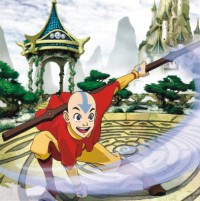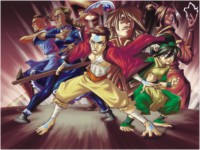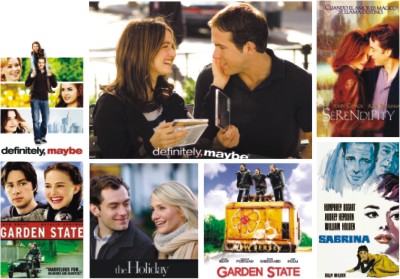Anime Review

 by Le Chupacabra
by Le Chupacabra
Action/Adventure
61 Episodes
ALL Ages
LEGEND spoke of the Avatar, a master of the elements who kept the world in balance. Yet when his current reincarnation disappeared a century ago, the despotic Fire Nation took this opportunity to fan their flames towards the other free countries. In this bleak time, hope emerges as siblings Sokka and Katara discover a young boy trapped in ice, a boy who could be bearing the power of the Avatar.
If I were to tell you that one of the best anime I've watched this year was not explicitly anime, would you believe me? I suppose not, but let's give this derring-do a try, shall we?
Avatar is a highly unusual anime in many ways. For the more pedantic of you, it's really a cartoon for starters. It's also entirely in English and was broadcast over Nickelodeon. Perhaps mentioning that the age demographic was closer to the 6-11 year-old mark might be a good addition. Oh, dear. This can't be right. The section does say “Anime Review”, doesn't it?
Ah, screw convention.
Avatar is indeed all that but unlike the major gamut of American anime-pretenders, this is one show with a heart that truly beats like an anime. And a fantastic one at that.
 The very first thing that really caught my attention was the design sensibility. A colourful realisation of a meticulously detailed world that combined Oriental motifs with fantasy elements and the lightest sprits of steampunk was quite entrancing. Each “Book” (i.e. season) followed a clear theme based on a traditional element which permeated into the atmosphere, environment and plot. What impresses is how intricately this is weaved into the entire show such that it became a seamless part of it. Character designs are simple and understated in a minimalist manner but the garb is no less unique, capturing the essence of the locales and individuals distinctly.
The very first thing that really caught my attention was the design sensibility. A colourful realisation of a meticulously detailed world that combined Oriental motifs with fantasy elements and the lightest sprits of steampunk was quite entrancing. Each “Book” (i.e. season) followed a clear theme based on a traditional element which permeated into the atmosphere, environment and plot. What impresses is how intricately this is weaved into the entire show such that it became a seamless part of it. Character designs are simple and understated in a minimalist manner but the garb is no less unique, capturing the essence of the locales and individuals distinctly.
Speaking of the characters, Avatar really flourishes here with extremely well-written and rounded personalities. Aang's journey of self-discovery is balanced in rather impressively with that of Zuko, the banished prince of the Fire Nation. The supporting cast are just as nuanced and this really creates a strong sense of bonding between the viewer and the show as you'll pick favourites and watch them develop.
The creators were quite ambitious since they cite Harry Potter and The Lord of the Rings as key influences and that they too wanted to create their own epic lore. It's easy to see how those two venerable franchises fit into the grand scheme. From its adventure elements to the individual tales of love, loss and growth to the pervasive nature of the whole journey, Avatar may borrow liberally from its peers but it does so whilst retaining the strongest sense of self. That's what makes the plot so enjoyable; it's simultaneously new and fascinating and gripping while being comfortably familiar in a warm, fuzzy way.
The music is something that also lends credibility to Avatar's lofty aims. A light yet sweeping score filled with smaller moments of reflection, it's a beautifully crafted soundscape. The main theme has some moments which bring to mind some of the compositions from the Lord of the Rings films.
In the end, Avatar strongly reminded me of Mai-HiME in that it stands as an insanely enjoyable anime in its own right, recognising and respecting far loftier peers. However, even to say that would be dismissing Avatar. A charming, lovable show that completely pulls you into an incredible world, Aang's story needs to be experienced by all - young and old.

By IA
Everybody loves movies. Though, of course, not necessarily the same ones. And when you're talking about romantic films, particularly around Valentine's day, you'd be hard pressed to find three people who have the same taste in films in one room, anywhere on the planet. Everybody has their own favourites, but I'd say the list we've cooked up is probably going to have a lot in common with a lot of people. From vintage classics that have only got better with the passage of time to much more contemporary films, we give you the best movies to watch this Valentine's, ideally with the very best in company, too.
Sabrina (1954)
Audrey Hepburn features more than once on our list, and with good reason her unique blend of charm, grace, and the way she makes her characters so accessible to any audience makes her films a lesson in romance many could wisely learn from. Sabrina is a quintessential Cinderella story, but with a stellar cast (Humphrey Bogart and Audrey Hepburn), witty humour, and timeless storytelling, you'd really have to be a cold-hearted cynic not to love it. The remake features Julie Ormond and Harrison Ford, and is almost as good a watch, too.
Breakfast at Tiffany's (1961)
Audrey Hepburn was probably at her most exquisite in this classic film, playing a New York socialite (Hepburn) who epitomizes the “wild thing” like no one ever has, before or since. As Holly Golightly, Hepburn plays the kept woman with poise and incomparable style, setting off George Peppard's struggling writer with rich, deep emotion and the most delicately balanced blend of neurotic glamour ever. An ending of epic power, and “Moon River” who could ask for more of a romance?
Serendipity (2001)
Arguably one of the sweetest movies ever made, though opinion tends to be divided on the film's whimsical trade of logic for romance, Serendipity is charming there simply is no other word for the magic of the film. One could say the plot's been done before, and rightly so, but with John Cusak and Kate Beckinsale and the most deliciously magical play of pre-ordained fate ever, Serendipity is bound to melt any heart into a pile of goo.
Garden State (2004)
If there ever was a chick flick written to an intelligent male audience, Garden State would be it. Zach Braff (of Scrubs fame) writes, directs and stars in the film opposite the incomparable Natalie Portman, and the results are an experience unlike any other. Braff brings on-screen the introspectiveness and some of the quirkiness that defines him elsewhere, and tells a story that is poignant, uplifting and beautiful on a level that is rare today. And if ever a sound track deserved mention, Garden State's one does the ending theme, “Let Go” by Frou Frou is probably the best Valentine's song ever.
The Holiday (2006)
Critics may lambast it no end, but the Holiday is definitely a very Valentine's movie to watch. An incredible cast (Kate Winslet, Jude Law, Cameron Diaz, and an incredible Jack Black) takes a rather ordinary story and injects it with a gumption that audiences can't help but love. Definitely a must-see.

Definitely Maybe is a difficult film to describe at first glance, it seems to be staple chick-flick faire, and while it remains so even on closer inspection, there is a definite charm that cannot be denied. Good acting across the cast (Ryan Reynolds' leading man is suave and accessible, and the cast of Elizabeth Banks, Isla Fisher and Rachel Weisz are all characters you want to get to know better from the moment you see them) makes for a guilty pleasure you can't really pass up on, not at this time of the year.

By Sabhanaz Rashid Diya
Photo: Rokshana Islam
When I initially heard of Shannon Castleman, Assistant Professor at the School of Art, Design and Media at Nanyang Technological University in Singapore - I had the impression she would be someone with grey hair and thick-rimmed glasses - something in the lines of the stereotypical image of educators we pick up from watching too much television. Much to my surprise, she was nothing of the sort when I met her in person. Young, bright, confident, friendly and accommodating - Shannon Castleman was a delight to interview. We were in the middle of a lot of chaos, with the preparations of Chobi Mela around us and another reporter interviewing Shahidul Alam on the backdrop. Yet we pulled it through, and delightfully indeed. Shannon Castleman had also conducted a workshop on 'Alternative Print Process' for 1st Year students at Pathshala at Chobi Mela V this year.
SRD (Sabhanaz Rashid Diya): What is your contribution to Chobi Mela V?
SC (Shannon Castleman): The work I am exhibiting consists of portraits of mobile business owners in Vietnam. I'm actually working on a large-scale project on mobile businesses in Southeast Asia. In Singapore, there used to be mobile businesses at every corner and now they're gone. This project started in 2007. It considers the effect globalism and free market economy has had on some occupations in Asia. As societies and commerce have become more advanced, people have become more mobile, businesses have become stationary, and the future looks bleak for the peripatetic entrepreneur in many places.
SRD: I see. So, is there a particular reason why you're doing portraits? Is that your specialization?
SC: No, actually for this project, I'm doing portraits. Most of my recent work is night photography that I do with my 4 by 5 camera. However, in context of mobile businesses, the idea was to find ways of keeping them alive. As we become more technologically inclined there is a gap between the people who are not familiar with new technologies. This project aims to eventually help to bridge that gap in some way. We are looking at how to make these mobile businesses more sustainable, by using low-tech solutions to help these businesses keep up with their competition and also help to keep some of the local flavor alive. The portraits were an attempt to document many of these vanishing characters that were once found on every corner in Singapore and are still common in many parts of Southeast Asia.
SRD: I've learnt that you've done freelance work in between your Bachelor's Degree and Master's Degree. Were you engaged in specific projects?
SC: Initially, I worked for newspapers, which was a great place to start. It meant I got to photograph every day and learned how to work under pressure. Then, in the mid '90s there was a shift in the editorial and fashion photography world. Suddenly fashion started to look a lot more like documentary and I began receiving more of those types of assignments. At this point the work I was doing for hire, and this was very closely related to my personal work that had consisted primarily of portraits of my friends and the scene that surrounded them. It was great for me for a while in that I was getting paid to created the images I wanted to see, and would be creating even if they weren't for hire.
By 1998 things again shifted in the fashion world and art directors wanted to go back to the clean studio look that didn't interest me. So, instead of changing the way I shot, I decided to quit taking fashion and editorial assignments and choose instead to once again concentrate on my personal work.
SRD: Would you say working freelance meant you could not do what interested you?
SC: I think it was difficult and I hoped that at some point I could stop selling myself to find clients. It didn't really work that way, and I had to keep selling. Furthermore, the bigger the jobs I got, the less I enjoyed them because it involved more people and in turn, more demands. As my jobs got bigger the people became more important in terms of their status, this was stressful for me and made the work become less fun. This made me realize that I was working hard for a goal that I didn't want.
SRD: So, if someone who wants to pursue photography professionally, would you suggest he or she becomes solely engaged in the field without having any other means of income?
SC: I guess it's safer to have another means of income. I currently have two jobs one as an educator and the other, as an artist. However, for the latter, I feel as though I still have to sell myself but now I don't have create for my clients' demands. I think, in the beginning, a photographer who wants to get into the field should find a way to do photography all the time - for me it was the newspapers. Initially, I did a lot of jobs which I didn't want, but I needed practice, it helped me gain confidence. Every day I had to shoot, every day I had to find a way to make it creative. There are different ways of doing it. Another way to do it is to freelance and have another job that is related to photography. I do think it is important to stay with in the field of photography if you are at all serious about being a professional photographer.
SRD: You've also taught at Dar Al-Hekma College in Saudi Arabia which is a top-ranked women's college in Jeddah, and said it was a 'challenging experience'. Why is it so?
SC: Well there are a lot of issues with photographing in Saudi Arabia; there are both political and cultural issues that dictate what you can photograph. Also you aren't allowed to photograph anything related to the military or the royal family and it isn't always clear what that is. On top of that, my students were women, so they weren't free to walk around - especially with cameras. It was a challenge because I was giving them assignments which were difficult for them to execute, and yet somehow they did it. Some of them have even pursued photography into Masters Level, while some of them are now working commercially.
SRD: Having had an experience with women photographing at a restricted environment, what would be your advice to young women who want to pursue photography in Bangladesh? Our cultural situation is not as limited as that in Saudi Arabia, but photography is still largely seen as a man's profession.
SC: I think as a woman, you have the advantage of being able to talk with more people and make them feel more comfortable in your presence. A lot of men cannot do that. Also, you have access to places that men don't, concentrate on those types of stories. Use what that fact that you might be underestimated as a woman to your advantage and prove them wrong, but do it safely. Safety can be more of an issue for a woman, when necessary ask a male friend or relative to tag along with you.
SRD: Perhaps, but even then, women photographers are underestimated in Bangladesh. When I do urban portraiture, for example, I often try to pick up a conversation with the person I will be shooting, but many a times, they have responded with a sneer at the thought of a girl taking their photographs.
SC: I think that is a challenge that you can try to overcome by being charming and more confident as a photographer. You can show you know what you're doing and talk to the people more. Your camera and a smile can be a great weapon, meaning you can smile and photograph those who are sneering at you and it might stop the way they are behaving.
SRD: What would your suggestion to be to young people who want to do photography in Bangladesh?
SC: Shoot your world, and let the rest of the world see what you see. I think what the world is hungry for in this era of globalization to know more about each other's cultures. It is now possible to share your work with the whole world. You've got the Internet and everyone has access to that. Get your work out there submit to festivals, scholarships and competitions you find online. You're only a click away from your dreams!
